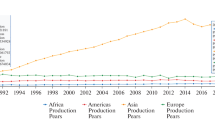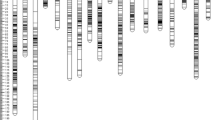Abstract
Fungi of the genus Pleurotus, in particular, species Pleurotus ostreatus (common oyster mushroom) are among most cultivated fungi in the world. Due to intense rates of development of studies in this field, efficient breeding programs are highly required in the search for new P. ostreatus strains. The principal traits used worldwide for selecting strains are intensity of fruitbearing, fruit body cap color (for some consumptive markets), and mycelium growth rate. In this connection, the objective of this work was to study these quantitative traits and to find molecular markers, which could be employed to accomplish breeding programs. In general, we found 12 genomic loci (quantitative trait loci, QTLs) controlling mycelium growth rate of oyster and six QTLs responsible for the fruit body cap color. The genetic map of P. ostreatus was constructed, and all markers of quantitative traits found by us were located on this genetic map. The obtained linkage map can be a useful tool for the accomplishment of breeding programs to improve economically important traits of oyster mushroom.
Similar content being viewed by others
References
Wasser, S.P. and Weis, A.L., Medicinal Properties of Substances Occurring in Higher Basidiomycetes Mushrooms: Current Perspectives (Review), Int. J. Med. Mushrooms, 1999, vol. 1, pp. 31–62.
Krasnopol’skaya, L.M., Basidiomycetes Mushrooms—Resources of Medicinal Substances, in Sovremennye problemy mikologii, al’gologii i fitopatologii (Modern Problems in Mycology, Algology, and Phytopathology), (Proc. Int. Conf. on the Occasion of the 80th Anniversary of the Department of Mycology and Algology, Moscow State University and the 90th Anniversary of V. Gorlenko’s Birthday), Moscow, 1998.
Ragunathan, R. and Swaminathan, K., Biological Treatment of a Pulp and Paper Industry Effluent by Pleurotus spp., J. Microbiol. Biotechnol., 2004, vol. 20, no. 4, pp. 389–393.
Kalmi, E. and Sargin, S., Cultivation of Two Pleurotus Species on Wheat Straw Substrates Containing Olive Mill Waste Water, Int. Biodeterior. Biodegrad., 2004, vol. 53, no. 1, pp. 43–47.
Dellamatrice, P.M., Monteiro, R.T.R., Kamida, H.M., et al., Decolourization of Municipal Effluent and Sludge by Pleurotus sajor-caju and Pleurotus ostreatus, J. Microbiol. Biotechnol., 2005, vol. 21, nos. 8–9, pp. 1363–1369.
Pant, D., Reddy, U., and Adholeya, A., Cultivation of Oyster Mushrooms on Wheat Straw and Bagasse Substrate Amended with Distillery Effluent, J. Microbiol. Biotechnol., 2006, vol. 22, no. 3, pp. 267–275.
Eger, G., Biology and Breeding of Pleurotus, The Biology and Cultivation of Edible Mushrooms, Chang, S.T. and Hayes, W.A., Eds., New York: Academic, 1978, pp. 497–519.
Raper, J.R., Genetics of Sexuality in Higher Fungi, New York: Ronald Press, 1966.
JoinMap.0, Kyazma, 2006; http://www.kyazma.nl/.
SPSS Statistics Standard, IBM, 2009; http://spss.ru/.
MapQTL, Kyazma, 2009; http://www.kyazma.nl/.
Selvakumar, P., Rajasekar, S., Periasamy, K., and Raaman, N., Isolation and Characterization of Melanin Pigment from Pleurotus cystidiosus (Teleomorph of Antromycopsis macrocarpa), J. Microbiol. Biotechnol., 2008, vol. 24, no. 10, pp. 2125–2131.
DOE Joint Genome Institute, www.jgi.doe.gov.
Larraya, L.M., Perez, G., Ritter, E., et al., Genetic Linkage Map of the Edible Basidiomycete Pleurotus ostreatus, Appl. Environ. Microbiol., 2000, vol. 66, no. 12, pp. 5290–5300.
Simchen, G., Monokaryotic Variation and Haploid Selection in Schizophyllum commune, Heredity, 1966, vol. 21, pp. 241–263.
Author information
Authors and Affiliations
Corresponding author
Additional information
Original Russian Text © A.B. Sivolapova, A.V. Shnyreva, A. Sonnenberg, I. Baars, 2012, published in Genetika, 2012, Vol. 48, No. 4, pp. 465–472.
Rights and permissions
About this article
Cite this article
Sivolapova, A.B., Shnyreva, A.V., Sonnenberg, A. et al. DNA marking of some quantitative trait loci in the cultivated edible mushroom Pleurotus ostreatus (Fr.) Kumm.. Russ J Genet 48, 383–389 (2012). https://doi.org/10.1134/S1022795412040114
Received:
Published:
Issue Date:
DOI: https://doi.org/10.1134/S1022795412040114




